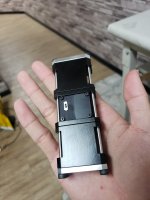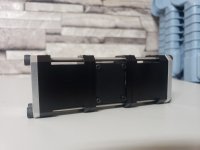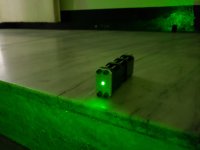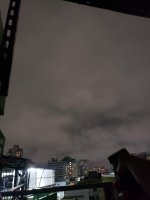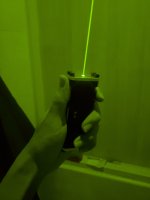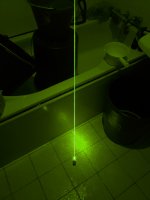After purchasing 2 lasers from Sanwu last year, I was determined to make my own laser build. Well, since the laser is self-contained in the module (and it came with the driver already), the build was more about the host than the laser itself. The laser module came from lasence.
I will call it... Mjölnir.
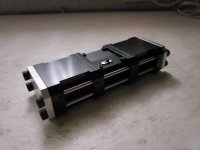

Yes, it looks nothing like typical laser hosts. Instead of searching a tried-and-true practical design and make it look good, I went the other way: create a design I like from scratch, then find a way to make it work without straying too far from the original design. I chose to make a sci-fi inspired design that is not round, because my Sanwu Challenger betrayed me. One day it rolled and fell straight to concrete floor, leaving a very visible nick on the laser head that mocks me everytime I look at it.
Also, it's surprisingly pleasant to grip since my fingers rest on the steel rods.

Yes, this design wasn't meant to be practical. The host itself uses 53 parts in total (6 machined aluminum parts, 9 handmade plastic parts, 4 steel rods, and 34 screws). It's basically blocks of aluminum skewered by 4 steel rods, and held tight by a lot of tiny set screws. Plus some plastic parts made out of cut ABS sheet, Originally I wanted to use a toggle switch, but my cheapo toggle switch seems to have nonstandard threads so that'll have to wait until I order one from mouser.
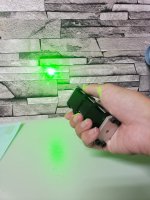
Anyways, it sure feels nice to turn a design you can only see in your computer screen two months ago to become a reality. Even though this build is not final yet (It should have stainless steel side and end plates, also using toggle switch), I'll call it a day for now.
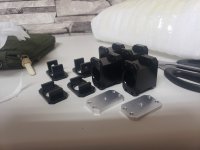
The build starts with the aluminum components I ordered from machining services on Alibaba. I got enough parts to make 2 identical hosts, but the other one will have to wait until Lasence finishes developing their 589nm . One part houses the module, another identical one for the battery, and two others form the driver compartment. 4 steel rods skewer the aluminum parts, and are secured by 16 tiny set screws.
. One part houses the module, another identical one for the battery, and two others form the driver compartment. 4 steel rods skewer the aluminum parts, and are secured by 16 tiny set screws.
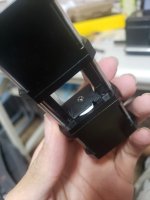
The battery board is made from 2 plastic parts screwed together. I can adjust how much of the screws protrude into the battery compartment, then tighten the two plastic parts against another to lock the screw. The black part has corners that prevent it from falling into the battery compartment, while the rounded white part is held on the edges by the side plates, so it can't fall to the driver compartment.
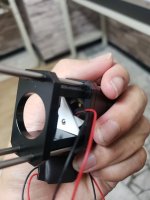
The laser module is secured with the same way as the battery, but with an additional shim-like part inside since the module is shorter than the battery.
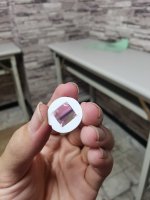
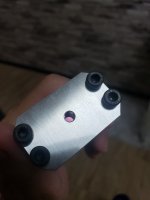
I also filed a piece of plastic to hold the IR filter. It's a 550nm narrow bandpass filter I got from eekbay. The filter looks pink from the outside.
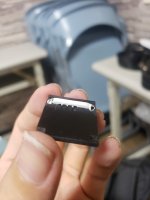
This is the side plate with the switch. I reinforced the switch with a thin strip of plastic to prevent it from being pushed into the driver compartment. I also filed 4 notches for the screw.
Finally, I just had to wire the driver to the switch and battery and put everything together. But there's no wiring pics for ya. Saying that my soldering skill is horrendous beyond the description of words is an understatement.
Oh, and I also got a 25% transmittance to bring the output down to 5mW so it's safe to use in a presentation. But my girlfriend commented that my laser looks extremely dangerous, like a stun gun or something. I guess she's right, I need to reconsider it...
I will call it... Mjölnir.


Yes, it looks nothing like typical laser hosts. Instead of searching a tried-and-true practical design and make it look good, I went the other way: create a design I like from scratch, then find a way to make it work without straying too far from the original design. I chose to make a sci-fi inspired design that is not round, because my Sanwu Challenger betrayed me. One day it rolled and fell straight to concrete floor, leaving a very visible nick on the laser head that mocks me everytime I look at it.
Also, it's surprisingly pleasant to grip since my fingers rest on the steel rods.

Yes, this design wasn't meant to be practical. The host itself uses 53 parts in total (6 machined aluminum parts, 9 handmade plastic parts, 4 steel rods, and 34 screws). It's basically blocks of aluminum skewered by 4 steel rods, and held tight by a lot of tiny set screws. Plus some plastic parts made out of cut ABS sheet, Originally I wanted to use a toggle switch, but my cheapo toggle switch seems to have nonstandard threads so that'll have to wait until I order one from mouser.

Anyways, it sure feels nice to turn a design you can only see in your computer screen two months ago to become a reality. Even though this build is not final yet (It should have stainless steel side and end plates, also using toggle switch), I'll call it a day for now.

The build starts with the aluminum components I ordered from machining services on Alibaba. I got enough parts to make 2 identical hosts, but the other one will have to wait until Lasence finishes developing their 589nm

The battery board is made from 2 plastic parts screwed together. I can adjust how much of the screws protrude into the battery compartment, then tighten the two plastic parts against another to lock the screw. The black part has corners that prevent it from falling into the battery compartment, while the rounded white part is held on the edges by the side plates, so it can't fall to the driver compartment.

The laser module is secured with the same way as the battery, but with an additional shim-like part inside since the module is shorter than the battery.


I also filed a piece of plastic to hold the IR filter. It's a 550nm narrow bandpass filter I got from eekbay. The filter looks pink from the outside.

This is the side plate with the switch. I reinforced the switch with a thin strip of plastic to prevent it from being pushed into the driver compartment. I also filed 4 notches for the screw.
Finally, I just had to wire the driver to the switch and battery and put everything together. But there's no wiring pics for ya. Saying that my soldering skill is horrendous beyond the description of words is an understatement.
Oh, and I also got a 25% transmittance to bring the output down to 5mW so it's safe to use in a presentation. But my girlfriend commented that my laser looks extremely dangerous, like a stun gun or something. I guess she's right, I need to reconsider it...
Last edited:




